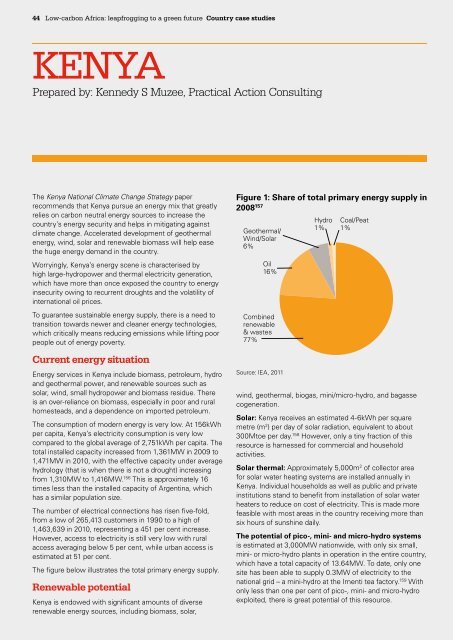Ju8uG
Ju8uG
Ju8uG
You also want an ePaper? Increase the reach of your titles
YUMPU automatically turns print PDFs into web optimized ePapers that Google loves.
44 Low-carbon Africa: leapfrogging to a green future Country case studies<br />
Kenya<br />
Prepared by: Kennedy S Muzee, Practical Action Consulting<br />
The Kenya National Climate Change Strategy paper<br />
recommends that Kenya pursue an energy mix that greatly<br />
relies on carbon neutral energy sources to increase the<br />
country’s energy security and helps in mitigating against<br />
climate change. Accelerated development of geothermal<br />
energy, wind, solar and renewable biomass will help ease<br />
the huge energy demand in the country.<br />
Worryingly, Kenya’s energy scene is characterised by<br />
high large-hydropower and thermal electricity generation,<br />
which have more than once exposed the country to energy<br />
insecurity owing to recurrent droughts and the volatility of<br />
international oil prices.<br />
To guarantee sustainable energy supply, there is a need to<br />
transition towards newer and cleaner energy technologies,<br />
which critically means reducing emissions while lifting poor<br />
people out of energy poverty.<br />
Current energy situation<br />
Energy services in Kenya include biomass, petroleum, hydro<br />
and geothermal power, and renewable sources such as<br />
solar, wind, small hydropower and biomass residue. There<br />
is an over-reliance on biomass, especially in poor and rural<br />
homesteads, and a dependence on imported petroleum.<br />
The consumption of modern energy is very low. At 156kWh<br />
per capita, Kenya’s electricity consumption is very low<br />
compared to the global average of 2,751kWh per capita. The<br />
total installed capacity increased from 1,361MW in 2009 to<br />
1,471MW in 2010, with the effective capacity under average<br />
hydrology (that is when there is not a drought) increasing<br />
from 1,310MW to 1,416MW. 156 This is approximately 16<br />
times less than the installed capacity of Argentina, which<br />
has a similar population size.<br />
The number of electrical connections has risen five-fold,<br />
from a low of 265,413 customers in 1990 to a high of<br />
1,463,639 in 2010, representing a 451 per cent increase.<br />
However, access to electricity is still very low with rural<br />
access averaging below 5 per cent, while urban access is<br />
estimated at 51 per cent.<br />
The figure below illustrates the total primary energy supply.<br />
Renewable potential<br />
Kenya is endowed with significant amounts of diverse<br />
renewable energy sources, including biomass, solar,<br />
Figure 1: Share of total primary energy supply in<br />
2008 157<br />
Geothermal/<br />
Wind/Solar<br />
6%<br />
Oil<br />
16%<br />
Combined<br />
renewable<br />
& wastes<br />
77%<br />
Source: IEA, 2011<br />
Hydro<br />
1%<br />
Coal/Peat<br />
1%<br />
wind, geothermal, biogas, mini/micro-hydro, and bagasse<br />
cogeneration.<br />
Solar: Kenya receives an estimated 4-6kWh per square<br />
metre (m 2 ) per day of solar radiation, equivalent to about<br />
300Mtoe per day. 158 However, only a tiny fraction of this<br />
resource is harnessed for commercial and household<br />
activities.<br />
Solar thermal: Approximately 5,000m 2 of collector area<br />
for solar water heating systems are installed annually in<br />
Kenya. Individual households as well as public and private<br />
institutions stand to benefit from installation of solar water<br />
heaters to reduce on cost of electricity. This is made more<br />
feasible with most areas in the country receiving more than<br />
six hours of sunshine daily.<br />
The potential of pico-, mini- and micro-hydro systems<br />
is estimated at 3,000MW nationwide, with only six small,<br />
mini- or micro-hydro plants in operation in the entire country,<br />
which have a total capacity of 13.64MW. To date, only one<br />
site has been able to supply 0.3MW of electricity to the<br />
national grid – a mini-hydro at the Imenti tea factory. 159 With<br />
only less than one per cent of pico-, mini- and micro-hydro<br />
exploited, there is great potential of this resource.


